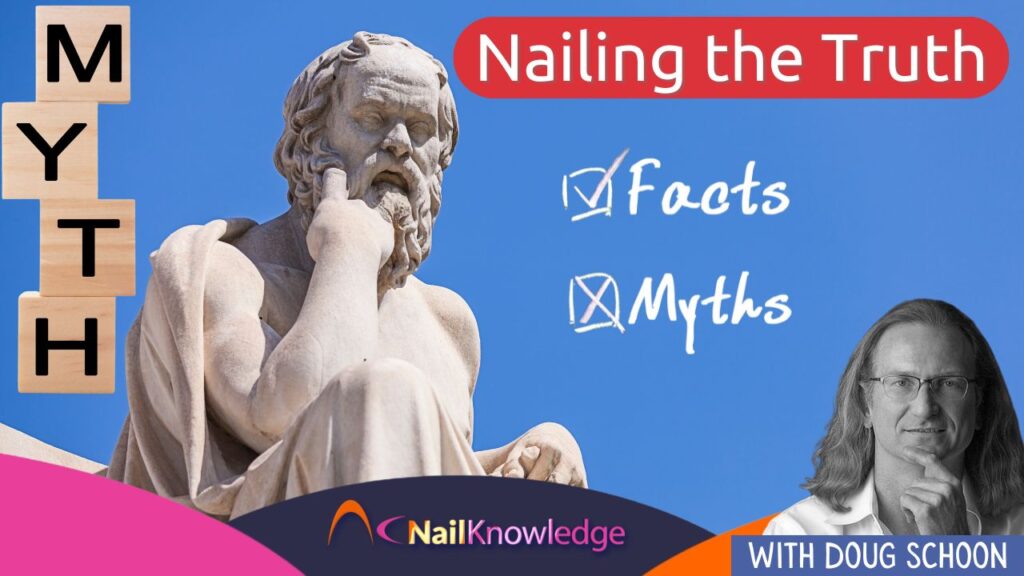In the ever-evolving world of nail care, the line between fact and fiction can often seem as fine as a freshly filed nail. One of the recurring challenges that both professionals and enthusiasts face is the abundance of misinformation swirling through the industry, from fellow nail technicians to the very manufacturers of our tools and products. A common concern, expressed poignantly by a reader, captures the essence of this struggle: ‘I do my research, but there is so much incorrect information coming from other nail technicians and even from manufacturers. How am I supposed to separate the facts from the myths?’
At NailKnowledge, we continually address myths and clarify doubts through a myriad of questions posed by our readers. Today, we delve into some of the most entrenched myths to reveal the truths hidden beneath the glossy veneer of the surface.
Filing Away Myths: The Socratic Method in Nail Care
Determining fact from fiction is an age-old problem that has existed since the beginning of civilization. In other words, misinformation has always been a problem. The best solution to this dilemma was discovered about 2500 years ago by a Greek philosopher named Socrates. Socrates and the people living in his time didn’t have to deal with the all the baloney circulated on the Internet or by the news media, but they sure did have their own fair share of myths and misinformation to deal with. So, Socrates developed a method to help him get the facts and he taught this method to his followers.
His method was so extremely successful that people regularly use it to this day! This method is used by judges, lawyers, reporters, detectives and scientists looking for facts and clues about the facts, but anyone can use this method because it is very simple, yet highly effective.
Socrates’s method can be boiled down to just these two words, “Question Answers”. Yes, it is that simple, yet it is powerful! Don’t just accept what you are told. That is how nail technicians are often fooled. Instead, ask lots of questions, and keep asking until you are satisfied you fully understand. It’s all about the questions you ask. Here are some examples for you to try.
Polishing the Truth: The Power of Open-Ended Questions in Nail Care
The best way to get answers is to ask open ended questions. Start with the simplest question of all… Ask “Why”? When someone tells you something you suspect is incorrect, ask them this question, “Why do you believe this is true?” And listen carefully to their answer for clues about what they are really saying.
Or ask “How do you know this?” Another interesting question is, “Where does your information come from?” and “What does this mean?” Or my personal favorite, “Please help me understand why I should believe this?” Or, “Why is this information important?” If you don’t understand their explanation say, “Explain that to me in a different way so that I can understand.” Or “What does that mean?” These are just a few examples of the type of open-ended questions that can help you to do better research and get a deeper understanding about any issue.
Uncovering Layers: The Revealing Power of Persistent Questions in Nail Care
Those who don’t know what they are talking about will have a hard time answering such questions. Those who want to deceive you, will not like being questioned. In either case, if someone doesn’t know the facts, it will be obvious when these types of questions are asked. And those who don’t want you to know the facts, will become uncomfortable.
When people ask me questions like this, I love it! This provides an opportunity to explain in greater detail and lets me know the questioner is interested. It’s an opportunity to provide more detailed information, which I always appreciate. Don’t stop asking “why” and “how” until you get to the root of the issue and feel you understand the facts. You’ll learn that some don’t know why they believe, they just do and will have no clear answer to your questions.
Beyond the Surface: The Importance of Questioning in Nail Care
Finally, don’t just accept what you hear or read and don’t just look at the headlines and expect you know the facts. Headlines are often intended to fool people, since those writing the headlines know most won’t take the time to read the article and won’t ask questions. Many are afraid to ask questions, but now you understand the tricks used by professionals who ask questions for a living.
With practice, you’ll find it’s easy. Take the time to Question Answers! And you’ll be the wiser for it. Like anything, it takes practice- so dig in and don’t give up until you get the answers to your questions.


